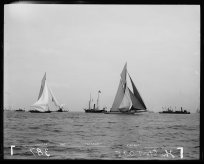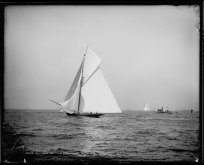Yves GARY Hits: 4017
Category: 1893 : CHALLENGE N°8
 By the time Lord Dunraven's yacht arrived on this side there was plenty of faith displayed in Vigilant. She was as firmly fixed in the hearts of Americans as Volunteer, Mayflower or Puritan had ever been, though it cannot be said that the man who designed her was as popular as Burgess, nor her manager, Mr. C. Oliver Iselin, as was Gen. Paine.
By the time Lord Dunraven's yacht arrived on this side there was plenty of faith displayed in Vigilant. She was as firmly fixed in the hearts of Americans as Volunteer, Mayflower or Puritan had ever been, though it cannot be said that the man who designed her was as popular as Burgess, nor her manager, Mr. C. Oliver Iselin, as was Gen. Paine.
Valkyrie arrived September 22d. She was twenty-nine days eighteen hours in coming from Cowes, having experienced high winds and rough seas, and less than two weeks were left after her arrival before the date of the first race, scant time to test her racing rig and enable the boat to "find herself."
 After an active correspondence, covering a variety of points, an agreement was reached between Lord Dunraven and the New York Yacht Club as to conditions to govern the races, which were to be best three out of five, starting either from Scotland or Sandy Hook light- vessels, the course of the first third and fifth to be to windward or leeward, fifteen miles; the second and fourth a triangle, the first leg to windward if possible ; all contests to be thirty nautical miles; one day to intervene between races, the date set for the first being October 5th; each yacht to have time to make repairs in case of accident before the preparatory gun; the preparatory signal to be made at 11.15, and the start at 11.25, by means of "a signal gun," the regatta committee being given discretion to call races off on account of fog; and manual power only to be used in working the vessels.
After an active correspondence, covering a variety of points, an agreement was reached between Lord Dunraven and the New York Yacht Club as to conditions to govern the races, which were to be best three out of five, starting either from Scotland or Sandy Hook light- vessels, the course of the first third and fifth to be to windward or leeward, fifteen miles; the second and fourth a triangle, the first leg to windward if possible ; all contests to be thirty nautical miles; one day to intervene between races, the date set for the first being October 5th; each yacht to have time to make repairs in case of accident before the preparatory gun; the preparatory signal to be made at 11.15, and the start at 11.25, by means of "a signal gun," the regatta committee being given discretion to call races off on account of fog; and manual power only to be used in working the vessels.
The one-gun start — that is, the usual two minutes handicap not being figured, each boat's time being taken from gun-fire — was an innovation in that it had never been employed in the cup races except when the yachts were to start from anchor. Former challengers had asked for it but vainly. It is the only instance of the employment of the one-gun start in the cup races. The agreement covering this point was as follows: "The time of the yachts shall be reckoned from the starting signal, as though both crossed the line at that instant." The advantage of such a start is in superior seamanship, it affording a test of captains rather than of boats.


 When the yachts came to the line for their first trial, October 5th, the challenger made a most favorable impression. Her sails set well, her low, straight hull responded quickly to a touch of her long tiller, she "stepped lively" in the light airs, and was much quicker in stays than Vigilant. The wind was northerly in the morning, and held in that quarter until about 1 o'clock, when it backed to W.S.W. The boats got away promptly at gun-fire, Vigilant crossing at 11.25.24, and Valkyrie at 11.25.53.
When the yachts came to the line for their first trial, October 5th, the challenger made a most favorable impression. Her sails set well, her low, straight hull responded quickly to a touch of her long tiller, she "stepped lively" in the light airs, and was much quicker in stays than Vigilant. The wind was northerly in the morning, and held in that quarter until about 1 o'clock, when it backed to W.S.W. The boats got away promptly at gun-fire, Vigilant crossing at 11.25.24, and Valkyrie at 11.25.53.
It was a spinnaker start, and the challenger provided a surprise by breaking out a sail of the most filmy lightness. It was thought at first to be silk, or Irish linen, but it proved to be made of unbleached muslin. The race was scarcely more than a drift to the outer mark.

Vigilant became becalmed shortly after one o'clock, and Valkyrie catching the southerly breeze first, sailed into a long lead. The outer mark was rounded by Valkyrie at 3.37.20, and by Vigilant 26 m. 20 s. later, at 4.03.40. Had the wind not flattened to a calm, Valkyrie with this lead probably would have come home a winner.
The race, however, was called off, with Valkyrie ahead, but both boats lying with idle sails on a glassy sea.
 Published: Oct. 6, 1893 |
THE FIRST RACE A FAILURE; NOT ENOUGH BREEZE FOR THE VALKYRIE AND VIGILANT. WILL BE SAILED OVER TO-MORROW. |
